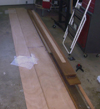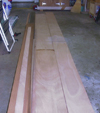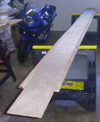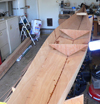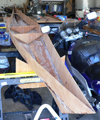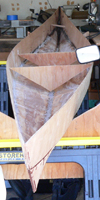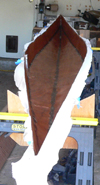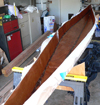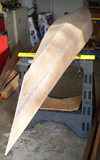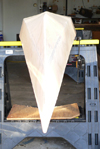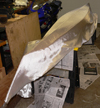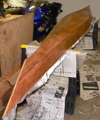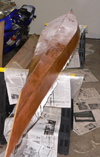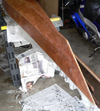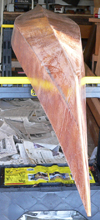Build Log For My Squeedunk Cormorant
Building the hull
In the fall of 2004, I was working at a tech company for the first time since the dot bomb in 2001. I spent a lot of time talking about kayaking and building a new kayak. I was facinated by the idea of building a boat of my own, one a bit more sporty than my QCC 500. One of my co-workers challenged me to get going on the project rather than just talking about it. That provided incentive for me to begin looking for a fairly easy design, as I had already bought a set of plans which looked a bit too complex for me to start without some practice. this boat is the result.
The Squeedunk company provides offsets for a stitch and glue version of their Cormorant 16 free of charge on their company web site. I downloaded the plans, bought some marine plywood and got to work. I plan to make a hybrid version of the boat. That means stitch and glue for the hull and strip build for the deck. The rational for this is simply that strips are much prettier, and thus should be used on the deck which is going to be visible when the boat is in the water. It's also easier to strip the relatively flat deck as apposed to the compound curves of the hull.
The first thing one does with a stitch and glue kayak is to lay out the various panels and cut them to size. I was not prepared to join two full sized pieces of floppy marine plywood together all at once, so I measured the sizes I would need, cut the plywood into strips of the proper width and scarfed them together to make the longer strips required for my panels.
After the panels have been cut to shape, holes are drilled along the sides and they are stitched together. I used copper wire for this. Some people use steel wire, some use zip ties. It doesn't really matter what you use as long as the task is accomplished to the satisfaction of the builder. Here are some pictures of the partially stripped boat, presented in no particular order.
As an interesting side note, I actually made a mistake in the original stitching which caused the top and bottom sets of panels to be offset at the bow and stern of the boat. This is visible in the detail picture of the bow of the boat. I had to completely unstitch them and do it a second time to correct the problem, but corrected it was, allowing me to move on.
Once the boat is stitched up and the shape looks good, it's time to glue things up. The first step is to run a line of epoxy down the stitched up seams of the boat. I had to do this in 3 stages, one with the boat on it's keel, another with the boat on one side and then the other. Otherwise the epoxy from the side seams would have run down into the keel line of the boat and wouldn't have done much to stick them together!
After all the glue dries, it is time to remove the stitches and seal the boat's seams with a layer of thickened epoxy. The recommendation is to thicken the epoxy with wood dust, either purchased for the purpose or simply the contents of a hand sanders dust bag. Unfortunately, I had neither. I figured I'd just grab some of the sanding dust from around my lathe. I got a bunch of it and realized that it was far too course to use for the purpose, so I sifted out the finer powder with a sieve. Sad to say, the resulting dust proved to be far too course to make a smooth mix. I ended up using way too much and sanding it down as well as I could afterwards. Not very good fillets, as these pictures show, but they do the job. I'll do better on the next boat. The fact that the sawdust was from walnut, a far darker wood than my plywood really shows all the elements of construction. I actually think that's sort of cool, so although some would consider it a defect, I consider it a feature.
Once the hull was smoothed to my satisfaction, I wetted it out. I first put down a layer of 4oz fiberglass cloth on the area of the interior that I would be sitting on. The extra reinforcement will help when I pull up on rocky beaches or have to stand in the boat for some reason.
Once the inside glass was cured, it was time to clean up the outside for glassing.
